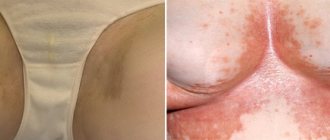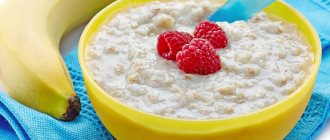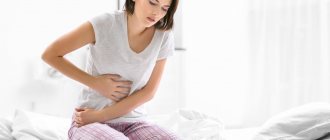Among the pathologies of the large intestine, dolichosigma (enlarged sigmoid colon) can be considered as a variant of dolichocolon, accompanied by an increase and expansion of one or all sections.
The main manifestation of the disease is severe constipation, which a person has to struggle with throughout his life. Treatment of intestinal dolichosigma in adults is not complete without a strict diet, laxatives and stimulants, massage, and exercise therapy. Still, a common outcome is fecal impaction and obstruction, so surgery cannot be avoided.
The essence of intestinal pathology
The elongated sigmoid colon forms additional loops, twists, and expands significantly. Normally, its task is to accumulate feces, absorb water and prepare for pushing into the rectum and further defecation. The average size of a sigma in an adult is: length 54–55 cm (some authors consider the maximum norm to be 46 cm), width up to 4 cm.
It lies inside the peritoneum and has its own mesentery. Projected onto the left iliac region of the abdomen. It differs from other sections in its S-shaped direction and the presence of two bends. In some people, moderate lengthening is asymptomatic. It is not considered an intestinal pathology, but is classified as a physiological abnormality.
With dolichosigma in adults, the intestine forms one or several additional loops; such a structural disorder makes it difficult for the passage of feces
Causes
Why the disease is diagnosed in some people in early childhood, and in others many years later, remains unclear. Dolichosigma in adults begins to appear by the age of 50, and in children it is usually detected at 4 years. This may be due to long-term individual compensatory adaptation of the intestine. Or in childhood there is a congenital disease, and in adults acquired factors are more important.
Disorders of the intestinal structure in the embryonic period are influenced by:
- any infectious diseases of the expectant mother (bacterial, viral) that occurred during pregnancy;
- the use of drugs with a negative effect on the fetus to treat a woman;
- disturbances in the diet of a pregnant woman (lack of fruits and vegetables, meat, preservatives, pesticides, dyes entering the bloodstream with food);
- hereditary predisposition, the presence of similar anomalies in the father’s or mother’s family;
- living of a pregnant woman in an environmentally unfavorable zone;
- transferred stressful conditions.
Elongation of the sigmoid colon in an adult can cause various disturbances in the process of food digestion, which leads to fermentation and rotting of residues. Meaning:
- sedentary lifestyle;
- overeating and obesity;
- previous intestinal infections;
- prolonged unrest and neuroses inhibit peristalsis;
- chronic inflammatory diseases of the upper digestive tract (esophagitis, gastritis, peptic ulcer, gastroduodenitis, hepatitis, cholecystitis, pancreatitis, chronic colitis) cause general digestive failure due to an excess or deficiency of secreted secretions, enzymes, bile acids, as a result the balance of the intestinal flora is disrupted, the process suffers digestion of food, stagnation and fermentation in the large intestine occur;
- the state of immunodeficiency caused by various diseases contributes to infection and dysregulation of the intestines.
Forecast
Treatment started at any stage of this disease leads to stable remission in 90% of cases. Annual maintenance therapy in a sanatorium is recommended.
If dolichosism, which occurs with obvious symptoms, is not treated, persistent constipation will cause digestive problems and diseases may develop:
- colitis;
- pancreatitis;
- gastroduodenitis;
- dysbiosis.
Sometimes it is difficult to determine the boundaries of normal when making a medical diagnosis. An elongated section of the colon will not affect the quality of life if you follow the rules of a healthy lifestyle (healthy lifestyle).
What symptoms indicate dolichosigma?
Symptoms of dolichosigma are caused by stagnation of waste substances in the intestine, their fermentation and transformation into toxic poisons, with gradual poisoning of the body, intestinal bloating in the sigma zone, and the development of partial or complete obstruction.
Symptoms of intestinal diverticulosis
Patients consult a doctor with complaints of the following:
- Constipation - at first, bowel movements are delayed for 3-4 days, then this period reaches up to a month. The symptom is caused not only by lengthening the path of feces, but also by careless treatment with addiction to laxatives and enemas. A person’s reflex mechanism for cleansing the intestines disappears.
- Pain syndrome - caused by a distended, overcrowded sigmoid colon, associated with inflammation. Localized in the navel or left half of the abdomen. It is persistent and sometimes turns into spasms (when feces move). Feces hardened to a stone-like state damage the intestinal mucosa and “open the gate” for the introduction of pathological flora and intestinal inflammation (colitis).
Due to putrefactive fermentation, the gases released by the patient further distend the intestines and have a pungent and unpleasant odor.
A person is bothered by constant bloating
An admixture of blood is found in the stool after defecation, which confirms vascular injury. Increased symptoms are provoked by eating, walking, and physical activity. Improvement occurs only after stool is removed.
Prevention
If symptoms of pathology are identified in a timely manner and a doctor is consulted, the pathology is not dangerous. The treatment used ensures good results, but in order to reduce the risk of developing the disease, it is extremely important to follow the recommendations of specialists. Regarding proper nutrition. The patient should not neglect physical activity. It is important to maintain a drinking regime.
It is quite difficult to prevent the development of dolichosigma. Prevention of the development of pathology in newborns consists of careful monitoring of the course of the mother’s pregnancy. If there is a genetic predisposition to the occurrence of a disease, it is impossible to prevent its occurrence. The process can develop at an early or mature age.
What complications does dolichosigma cause?
Stretching of the intestinal wall contributes to its thinning; rupture is possible with the release of feces into the abdominal cavity and peritonitis. Then the pains after sharp “dagger” pains develop into constant ones, spread throughout the entire abdomen, the temperature rises, blood pressure drops to the point of shock, and intoxication increases.
Dysbacteriosis causes irritable bowel syndrome and vitamin deficiencies. Anemia (anemia) develops in the absence of synthesis of essential vitamins in the intestines. Chronic colitis and acute intestinal obstruction appear - caused by fecal stones, kinks, and torsions of the elongated intestine.
Stages of the disease, their manifestations
Gastroenterologists distinguish between forms of the disease or stages of the disease, since one form/stage can progress to another, more severe one. Each is characterized by symptoms of a certain intensity.
Compressed or initial (hidden) - usually patients are not aware of the existing intestinal pathology and do not feel any unusual manifestations. The only complaint is a tendency to constipation (no bowel movement for up to five days). During the examination, the doctor pays attention to the palpable solid intestine in the left iliac region. Switching to a diet and using mild laxatives helps normalize bowel movements.
Subcompensated - expressed in longer-term constipation, abdominal pain, bloating, lack of effect from laxatives, mandatory use of cleansing enemas. Patients develop signs of intoxication (weakness, headaches, irritability, insomnia, nausea).
Decompensated - the condition worsens, periodic vomiting is added to nausea and loss of appetite. Headaches become frequent, weakness is caused by the development of anemia. Skin manifestations in the form of increased pallor and the spread of pustules are added. Siphon enemas are used to cleanse the intestines. You can read about the characteristics of the disease in childhood in this article.
Do they take you into the army?
Dolichosigma is not on the list of diseases on the basis of which a conscript may be declared unfit for military service.
A young man who is registered at a dispensary for dolichosigma detected in him may be considered of limited fitness based on clinical signs. He is assigned a “B” fitness category, is issued a military ID, and is enlisted in the reserves.
Clinical signs indicating impaired bowel function are the inability to go to the toilet on your own for a long time (more than a month). Evacuation is possible only with the help of an enema.
How are intestinal diseases diagnosed?
Diagnosis begins with an examination by a doctor. The doctor pays attention to the patient’s pale skin, nervousness, and bloating. Palpation reveals a painful compaction in the area of the sigmoid colon. It could be a fecal impaction or a tumor.
A rectal examination reveals an empty rectal ampulla. This means that there are reasons above that impede the passage of feces. X-ray examination is carried out by preliminary ingestion of a barium suspension or by direct injection of a contrast agent into the intestine with an enema (irrigoscopy).
Upon admission with a drink, the doctor on the first day has the opportunity to examine the esophagus, duodenum and stomach condition. On the second day, the contrast should fill the loops of the colon. Fluoroscopy reveals: intestinal prolapse (colonoptosis), contrast retention in the area of the descending and sigmoid intestines, additional loops and elongation of the sigmoid.
The doctor makes a differential diagnosis with another congenital anomaly - megacolon. The disease is accompanied by an enlargement of the entire large intestine with thickening of individual areas, which causes a narrowing of the passage.
Irrigography of the intestine is performed immediately after the enema
Computed tomography makes it possible to determine not only the size and patency of the sigmoid colon, but also the condition of the mucous membrane, to distinguish dolichosigma from neoplasms and polyps that often affect this area. Ultrasound of the intestines reveals dense fecal stones, the method is not of great importance, since the picture is blurred due to a significant amount of gases.
For diagnosis, the following tests are important: blood - leukocytosis and ESR indicate inflammation, a decrease in red blood cells and hemoglobin - anemia, in a stool analysis it is important to identify hidden bleeding (Gregersen reaction), signs of parasites in the intestines, dysbiosis. Electromyography and sphincterometry are used to determine motor activity and the possibility of intestinal motility.
Types of dolichocolon
Depending on the section of the large intestine that is involved in the pathological process, the following forms of pathology are distinguished:
- dolichosigma - elongation of the sigmoid region;
- right-sided dolichocolon - elongation of the ascending colon;
- dolichotransversum - elongation of the transverse colon;
- left-sided dolichocolon – elongation of the descending colon;
- subtotal dolichocolon – damage to several parts of the large intestine;
- total dolichocolon is a pathological change in the entire colon.
How to be treated without surgery?
At the stage of compensation and subcompensation, therapy involves a strict diet, massage, exercise therapy, and the use of folk recommendations.
Diet
Nutrition of a patient with intestinal dolichosigma requires:
- mandatory transition to frequent (fractional) meals in small portions (5–6 times a day);
- reduction in the diet of light carbohydrates (sweets, baked goods, wheat bread, pasta);
- increasing the proportion of fiber;
- limited meat consumption;
- refusal of millet and rice porridges that are difficult to digest in the intestines;
- daily provision of fluid of at least 1.5–2 liters, drinking warm mineral waters containing sulfur;
- prepare dishes only boiled or steamed; fried, smoked and spicy foods irritate the intestines, inhibit intestinal motility, and are poorly digested.
It is recommended to include in the intestinal diet:
- bread made from wholemeal flour, with bran, rye;
- sour milk products (kefir, yogurt, yogurt, cottage cheese);
- from sweets - honey, marmalade (contains pectins, beneficial for the intestines);
- fiber-rich vegetables, fruits, berries, herbs;
- products with a laxative effect (boiled beets, dried apricots, prunes, vegetable oils);
- bran - not only have laxative properties, but also remove toxic substances and waste from the body (act as sorbents), they should be added to kefir and porridge.
Vegetable oils you can use are olive, sunflower, flaxseed and milk thistle oil. They are used to dress salads; it is recommended to drink a glass of kefir with a tablespoon of oil at night or take it on an empty stomach.
Using massage
Daily abdominal massage helps to relax spasmodic areas of the intestine, increase tone in the absence of peristaltic waves, and increase blood flow to stretched muscles. Thus, congestion is eliminated and feces are promoted.
The main thing is to carry out all movements clockwise. Intestinal massage begins with light stroking and rubbing to warm up the surface layers of the skin. The stomach should turn red. Further, the movements become deeper, squeezing, pressing.
Kneading is the main method of deep impact, but it should only be used after preliminary preparation. The muscle layer of the abdominal wall is grasped and kneaded with the fingertips. The movements push the muscles towards the rectum and last 15 minutes.
The end of the procedure takes place in reverse stages (rubbing, stroking). At the very end, you can do a light tapping or patting. It is better to learn how to do it yourself after taking a course from an experienced specialist.
Physiotherapy
For chronic constipation caused by dolichosigma, exercises are carried out with intense load, the number of repetitions is recommended to be increased weekly by 10. Jumping in place, alternating with both legs and each. Using a jump rope is useful. The rhythm should reach 150 per minute. Squats with the pelvis pulled back and the back straight. In the lower position, you need to hold the pose first for 10 seconds, then reach up to a minute.
To complicate the exercise, it is recommended to place your feet at a considerable width and spread your toes as far apart as possible.
Exercises for the intestines are performed while lying down. The upper abdominal muscles can be made to work by doing hands-free raises. The lower ones are maximally loaded when lifting the legs and performing “scissors” and “bicycles” at an angle of 45 degrees to the floor.
People's recommendations
Treatment of the intestines with folk remedies is best done after consulting a doctor and in combination with other methods. Castor oil - it is recommended to take it at night with kefir or warm beer (a tablespoon per glass of drink), during the day you can add it to coffee. Cannot be used by pregnant women.
Instead of castor oil at night, you can drink any vegetable oil with kefir. Cucumber pickle without seasoning contains beneficial properties for the intestines; you can drink it during the day. The following parts of plants have a laxative effect:
- buckthorn bark;
- senna leaves;
- Dill seeds.
They should be brewed in a thermos and left overnight. Take half a glass over the next day. Can be mixed.
Drug treatment
If the above remedies do not help, and the pain is excruciating, then doctors prescribe medications that stimulate bowel movements. Duphalac - an adult can take 3-4 times a day.
Mukofalk - a bag of powder is poured into a glass of water and mixed well; no more than four standard bags can be consumed per day. Duspatalin - tablets or capsules are taken 20 minutes before meals, the drug should be washed down with a significant amount of water. Trimedat - most often prescribed to stimulate intestinal receptors in the postoperative period, it can be administered rectally.
Forlax is a mild laxative.
Drugs that normalize the intestinal flora (probiotics) are prescribed to combat and prevent the processes of fermentation, putrefaction, and candidiasis in dolichosigma. You can choose from the most popular products (Lactobacterin, Simbiter, Bifidum); yoghurts indicating the inclusion of a bacterial starter for the intestines are useful.
Due to the development of vitamin deficiency, combination preparations of vitamins are added to treatment; C, A, B, PP, D are especially useful. In case of severe intestinal atony, a solution of Prozerin is administered. The drug should be used with caution in elderly people.
Enemas
To cleanse and stimulate bowel movements, enemas are prescribed. They are made with boiled water, saline solutions, and herbal decoctions. It is important to prevent the intestines from getting used to this method of removing contents. Loss of the reflex leads to complete atony, disappearance of the urge to defecate, and malfunction of the sphincters. Another complication is the development of irritable bowel syndrome.
Authorized Products
- The diet should include all vegetables, used raw (in the absence of flatulence), boiled or stewed. If there is no bloating, green peas and cabbage are allowed, but boiled.
- You can make vegetable caviar with vegetable oil and add seaweed to all salads. It can be dried (powder 1-3 tsp per day) or chopped.
- Soups are prepared with a weak broth, but vegetable broth is better. You should prepare more vegetable soups (beetroot soups, cold soups, borscht, cabbage soup).
- Remember that meat dishes are difficult to digest and therefore it is not advisable to eat them daily, as constipation may worsen. Among protein products, you should prefer fish. If you cannot do without meat dishes, then choose dietary varieties (chicken, turkey), as they are easier to digest. Meat and fish dishes should be cooked boiled or baked as a whole piece.
- From cereals (preferably whole grains) crumbly porridges are prepared (except “smear porridges”) and casseroles. It is important not to overcook the porridge so that all the beneficial substances are preserved and it is crumbly. You can add dried fruits to sweet porridges, and vegetable oil to the finished ones.
- Fermented milk drinks are useful for constipation and you can choose matsoni, kefir, yogurt, koumiss or acidophilus yogurt according to your taste, but remember that all products must be fresh (one day old). In this regard, it is better to start making it at home using starter cultures.
- Milk is allowed only in dishes; cottage cheese and cheeses should be consumed sparingly, as they can be strong because they contain calcium. Eggs in quantities of up to 2 pieces (steam omelettes, soft-boiled, omelettes with vegetables).
- Sweet fruits and berries, soaked dried fruits (dried apricots, apricots, figs and prunes) should be present in unlimited quantities, which should be added to dishes or fermented milk drinks.
- Wheat bread (2nd grade), doctor's bread, and grain bread are allowed. If you tolerate rye well, then you can eat it too. All bread products must be stale or dried.
- Allowed: weak tea, herbal teas, carbonated drinks, juices (plum, potato, carrot, beet, apricot, tomato), sparkling water (if there is no bloating or belching), rosehip infusion, coffee substitutes.
Table of permitted products
| Proteins, g | Fats, g | Carbohydrates, g | Calories, kcal | |
Vegetables and greens | ||||
| zucchini | 0,6 | 0,3 | 4,6 | 24 |
| cabbage | 1,8 | 0,1 | 4,7 | 27 |
| sauerkraut | 1,8 | 0,1 | 4,4 | 19 |
| cauliflower | 2,5 | 0,3 | 5,4 | 30 |
| carrot | 1,3 | 0,1 | 6,9 | 32 |
| pickles | 0,8 | 0,1 | 1,7 | 11 |
| rhubarb | 0,7 | 0,1 | 2,5 | 13 |
| beet | 1,5 | 0,1 | 8,8 | 40 |
| tomatoes | 0,6 | 0,2 | 4,2 | 20 |
| pumpkin | 1,3 | 0,3 | 7,7 | 28 |
Fruits | ||||
| apricots | 0,9 | 0,1 | 10,8 | 41 |
| watermelon | 0,6 | 0,1 | 5,8 | 25 |
| bananas | 1,5 | 0,2 | 21,8 | 95 |
| melon | 0,6 | 0,3 | 7,4 | 33 |
| nectarine | 0,9 | 0,2 | 11,8 | 48 |
| peaches | 0,9 | 0,1 | 11,3 | 46 |
| plums | 0,8 | 0,3 | 9,6 | 42 |
| apples | 0,4 | 0,4 | 9,8 | 47 |
Nuts and dried fruits | ||||
| dried figs | 3,1 | 0,8 | 57,9 | 257 |
| dried apricots | 5,2 | 0,3 | 51,0 | 215 |
| dried apricots | 5,0 | 0,4 | 50,6 | 213 |
| prunes | 2,3 | 0,7 | 57,5 | 231 |
Cereals and porridges | ||||
| buckwheat (kernel) | 12,6 | 3,3 | 62,1 | 313 |
| oat groats | 12,3 | 6,1 | 59,5 | 342 |
| corn grits | 8,3 | 1,2 | 75,0 | 337 |
| pearl barley | 9,3 | 1,1 | 73,7 | 320 |
| wheat bran | 15,1 | 3,8 | 53,6 | 296 |
| millet cereal | 11,5 | 3,3 | 69,3 | 348 |
| barley grits | 10,4 | 1,3 | 66,3 | 324 |
Bakery products | ||||
| oatmeal bread | 10,1 | 5,4 | 49,0 | 289 |
| Rye bread | 6,6 | 1,2 | 34,2 | 165 |
| bran bread | 7,5 | 1,3 | 45,2 | 227 |
| doctor's bread | 8,2 | 2,6 | 46,3 | 242 |
| whole grain bread | 10,1 | 2,3 | 57,1 | 295 |
Confectionery | ||||
| jam | 0,3 | 0,2 | 63,0 | 263 |
| jelly | 2,7 | 0,0 | 17,9 | 79 |
| marshmallows | 0,8 | 0,0 | 78,5 | 304 |
| milk candies | 2,7 | 4,3 | 82,3 | 364 |
| fondant candies | 2,2 | 4,6 | 83,6 | 369 |
| fruit and berry marmalade | 0,4 | 0,0 | 76,6 | 293 |
| paste | 0,5 | 0,0 | 80,8 | 310 |
| Maria cookies | 8,7 | 8,8 | 70,9 | 400 |
| oatmeal cookies | 6,5 | 14,4 | 71,8 | 437 |
Raw materials and seasonings | ||||
| honey | 0,8 | 0,0 | 81,5 | 329 |
| sugar | 0,0 | 0,0 | 99,7 | 398 |
Dairy | ||||
| kefir | 3,4 | 2,0 | 4,7 | 51 |
| sour cream | 2,8 | 20,0 | 3,2 | 206 |
| curdled milk | 2,9 | 2,5 | 4,1 | 53 |
| kumiss | 3,0 | 0,1 | 6,3 | 41 |
| acidophilus | 2,8 | 3,2 | 3,8 | 57 |
| yogurt | 4,3 | 2,0 | 6,2 | 60 |
Cheeses and cottage cheese | ||||
| cottage cheese | 17,2 | 5,0 | 1,8 | 121 |
Meat products | ||||
| beef | 18,9 | 19,4 | 0,0 | 187 |
| beef liver | 17,4 | 3,1 | 0,0 | 98 |
| beef tongue | 13,6 | 12,1 | 0,0 | 163 |
| veal | 19,7 | 1,2 | 0,0 | 90 |
| rabbit | 21,0 | 8,0 | 0,0 | 156 |
Bird | ||||
| chicken | 16,0 | 14,0 | 0,0 | 190 |
| turkey | 19,2 | 0,7 | 0,0 | 84 |
Eggs | ||||
| chicken eggs | 12,7 | 10,9 | 0,7 | 157 |
Fish and seafood | ||||
| herring | 16,3 | 10,7 | — | 161 |
Oils and fats | ||||
| butter | 0,5 | 82,5 | 0,8 | 748 |
| corn oil | 0,0 | 99,9 | 0,0 | 899 |
| olive oil | 0,0 | 99,8 | 0,0 | 898 |
| sunflower oil | 0,0 | 99,9 | 0,0 | 899 |
Non-alcoholic drinks | ||||
| mineral water | 0,0 | 0,0 | 0,0 | — |
| instant chicory | 0,1 | 0,0 | 2,8 | 11 |
Juices and compotes | ||||
| apricot juice | 0,9 | 0,1 | 9,0 | 38 |
| plum juice | 0,8 | 0,0 | 9,6 | 39 |
| tomato juice | 1,1 | 0,2 | 3,8 | 21 |
| pumpkin juice | 0,0 | 0,0 | 9,0 | 38 |
| * data is per 100 g of product | ||||
When is surgery indicated?
In the absence of results from conservative treatment of the intestine, in the stage of decompensation, when atony and obstruction occur, the only treatment option is surgery. During surgery the following is performed:
- resection (excision) of part of the long sigmoid colon;
- removal of necrotic walls due to torsion and compression;
- Less commonly, the entire sigmoid colon has to be removed.
The ends of the intestinal loops are sewn together using one of the most suitable methods
Typically, an uncomplicated operation lasts 1.5 hours; general anesthesia is required. In the postoperative period, on the third day you are allowed to get up and walk a little. Antibacterial therapy and detoxification are required, and bleeding is prevented. After 10 days, the patient is discharged.
The patient must follow a diet until peristalsis is completely restored and further limit foods that are not recommended for the intestines. A disease such as dolichosigma is not difficult to diagnose. But further treatment is more difficult the more advanced the intestinal pathology. Therefore, doctors do not recommend enduring constipation. It is necessary to establish the cause and obtain optimal recommendations.
Fully or partially limited products
- Products that contain dyes, preservatives, flavors and shelf-stable products.
- You should not eat bread made from premium flour, products made from yeast dough or puff pastry. Chocolate, cookies, chips, and any products with cream are not allowed.
- Jelly made from bird cherry, quince, blueberry, pear, dogwood, strong tea, cocoa, coffee, as they contain tannins.
- Dishes with a viscous consistency that slowly pass through the intestines (mucous decoctions and soups, mashed potatoes, jelly, jelly, pureed porridge).
- Difficult to digest fatty meats, poultry (duck, pork, goose) and fish, canned food, fried foods, hard-boiled eggs, and smoked foods are excluded.
- Hot sauces, horseradish and mustard, which disrupt the function of the gastrointestinal tract.
- Foods you should limit include: rice, noodles, sago, semolina, vermicelli, potatoes, and legumes.
Table of prohibited products
| Proteins, g | Fats, g | Carbohydrates, g | Calories, kcal | |
Vegetables and greens | ||||
| potato | 2,0 | 0,4 | 18,1 | 80 |
| radish | 1,2 | 0,1 | 3,4 | 19 |
| white radish | 1,4 | 0,0 | 4,1 | 21 |
| turnip | 1,5 | 0,1 | 6,2 | 30 |
| horseradish | 3,2 | 0,4 | 10,5 | 56 |
| garlic | 6,5 | 0,5 | 29,9 | 143 |
Fruits | ||||
| quince | 0,6 | 0,5 | 9,8 | 40 |
| dogwood | 1,0 | 0,0 | 10,5 | 44 |
Berries | ||||
| blueberry | 1,1 | 0,4 | 7,6 | 44 |
Mushrooms | ||||
| mushrooms | 3,5 | 2,0 | 2,5 | 30 |
Cereals and porridges | ||||
| semolina | 10,3 | 1,0 | 73,3 | 328 |
| rice | 6,7 | 0,7 | 78,9 | 344 |
| sago | 1,0 | 0,7 | 85,0 | 350 |
Flour and pasta | ||||
| pasta | 10,4 | 1,1 | 69,7 | 337 |
| noodles | 12,0 | 3,7 | 60,1 | 322 |
Bakery products | ||||
| wheat bread | 8,1 | 1,0 | 48,8 | 242 |
Confectionery | ||||
| pastry cream | 0,2 | 26,0 | 16,5 | 300 |
Chocolate | ||||
| chocolate | 5,4 | 35,3 | 56,5 | 544 |
Raw materials and seasonings | ||||
| mustard | 5,7 | 6,4 | 22,0 | 162 |
| mayonnaise | 2,4 | 67,0 | 3,9 | 627 |
Meat products | ||||
| pork | 16,0 | 21,6 | 0,0 | 259 |
| salo | 2,4 | 89,0 | 0,0 | 797 |
Sausages | ||||
| dry-cured sausage | 24,1 | 38,3 | 1,0 | 455 |
Bird | ||||
| smoked chicken | 27,5 | 8,2 | 0,0 | 184 |
| duck | 16,5 | 61,2 | 0,0 | 346 |
| smoked duck | 19,0 | 28,4 | 0,0 | 337 |
| goose | 16,1 | 33,3 | 0,0 | 364 |
Fish and seafood | ||||
| smoked fish | 26,8 | 9,9 | 0,0 | 196 |
| canned fish | 17,5 | 2,0 | 0,0 | 88 |
Oils and fats | ||||
| animal fat | 0,0 | 99,7 | 0,0 | 897 |
| cooking fat | 0,0 | 99,7 | 0,0 | 897 |
Non-alcoholic drinks | ||||
| instant coffee dry | 15,0 | 3,5 | 0,0 | 94 |
| black tea | 20,0 | 5,1 | 6,9 | 152 |
Juices and compotes | ||||
| jelly | 0,2 | 0,0 | 16,7 | 68 |
| * data is per 100 g of product | ||||
Reviews
Galina, 58 years old, housewife: I have known about my diagnosis for 5 years. Previously, I had to work hard at a construction site. At 89 years old, my mother has severe intestinal atony. We take turns drinking castor oil and kefir. Helps.
Nelya, 45 years old, doctor: Constipation in old people sometimes becomes the main problem, and then the heart hurts and melancholy sets in. Whether there is dolichosigma there or not is unclear, because they do not want to be examined. The listed laxatives are a bit expensive for retirement. They agree to a diet for the intestines and herbal medicine.
Vera, 42 years old, technologist: You just need to not bring yourself to such a state. And adults are responsible for the intestines of children; there is no point in letting them watch advertisements for all sorts of chips. Does anyone actually check it for health risks?










